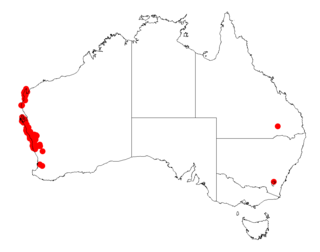
Acacia colei is a perennial bush or tree native to northern Australia and southern Asia. A common name for it is Cole's wattle. Acacia colei blooms from May through September and the flowers are bright yellow.

Acacia brachypoda, known colloquially as western wheatbelt wattle or Chinocup wattle, is an endangered species of Acacia restricted to a small locality in western Australia's wheatbelt.
Acacia carens is a shrub belonging to the genus Acacia. It is native to a small area on the Lesueur sandplain on the coast at the meeting of the Mid West and Wheatbelt regions of Western Australia.

Acacia cummingiana is a shrub belonging to the genus Acacia. It is native to a small area on the Swan coastal plain and the Geraldton sandplain in Western Australia.

Acacia pterocaulon is a shrub belonging to the genus Acacia and subgenus Alatae. It is native to a small area in the Mid West region of Western Australia.

Acacia desertorum is a shrub belonging to the genus Acacia and the subgenus Juliflorae that is endemic to western Australia.

Acacia rhodophloia, commonly known as minni ritchi or western red mulga, is a tree or shrub belonging to the genus Acacia and the subgenus Juliflorae that is endemic to a large area of arid central western Australia. The Indigenous group the Kurrama peoples know the plant as mantaru.

Acacia yorkrakinensis is a shrub belonging to the genus Acacia and the subgenus Juliflorae that is native to Western Australia.

Acacia argutifolia, commonly known as the East Barrens wattle, is a shrub belonging to the genus Acacia and the subgenus Phyllodineae.
Acacia blaxellii, also known as Blaxell's wattle, is a shrub belonging to the genus Acacia and the subgenus Phyllodineae endemic to Western Australia.

Acacia gregorii, commonly known as Gregory's wattle, is a shrub belonging to the genus Acacia and the subgenus Phyllodineae native to Western Australia.

Acacia pusilla is a shrub of the genus Acacia and the subgenus Phyllodineae the is endemic to south western Australia.

Acacia semitrullata is a shrub of the genus Acacia and the subgenus Phyllodineae that is endemic to south western Australia.

Acacia spathulifolia commonly known as Gold carpet or the Gold carpet wattle is a shrub of the genus Acacia and the subgenus Phyllodineae that is endemic to coastal parts of western Australia.

Acacia sphenophylla is a shrub of the genus Acacia and the subgenus Phyllodineae that is endemic to a small area in western Australia.

Acacia anfractuosa is a shrub or tree of the genus Acacia and the subgenus Plurinerves that is endemic to Western Australia.

Acacia auricoma, commonly known as Petermann wattle, Alumaru and Nyalpilintji wattle is a shrub of the genus Acacia and the subgenus Plurinerves. It is native to an area in the Northern Territory and the eastern Goldfields region of Western Australia.

Acacia roycei is a shrub or tree of the genus Acacia and the subgenus Plurinerves that is endemic to an area of western Australia.

Acacia megacephala is a shrub of the genus Acacia and the subgenus Pulchellae that is endemic to south western Australia.

Acacia cretacea, also known as chalky wattle, is a shrub belonging to the genus Acacia and the subgenus Phyllodineae that is endemic to South Australia.



















